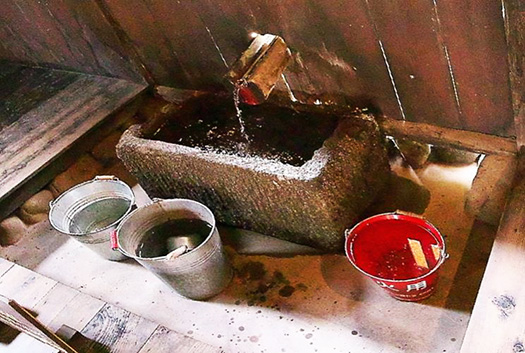

いろいろと驚くような歴史の深奥が見えてくる奥五箇山の山田家住宅。
さらに驚かされたのが、ウスナワと呼ばれる台所空間に鎮座する「水道」。
懸樋(かけひ、もしくはかけい)という装置で外の水源から
家の中にまで竹の節をくり抜いたり、木をくり抜いたりして作った「樋」で
家の中に水を引いてそれを船のような石材・水船で受けているのです。
「復元」としてウスナワはこのような装置のある空間と特定できたのでしょう。
ちなみにあふれた水は排水溝から外に排出させていたのだそうです。
かける労力の割に見合わないようなもったいなさ・・・。
この装置の床面は石で周囲を囲い込んだ突き固めの土間床か、
あるいは石を敷いた床面かと見定められました。
この復元は川崎市にあるので水源は水道でしょうが、五箇山でどうだったのか、
そのあたりは取材したいと思っていますが、まだ不明であります。
山間の住居ということで、湧き水が近くにあって簡易に引き込めたのか。
いまは旧所在地はダムに水没しているので古記録を参照するしかない。
わたしは古民家を見続けていますが、
ふつう古民家での生活水は外の水源から家の中に運搬してきて
大きな水甕に水を溜めておいて柄杓で必要量を採取するという
そういうのが常識だと思っていました。
たしかに江戸では「神田上水」などの水道が整備もされていたとされますが、
それにしても各戸には同様に水甕があって、そこから採取するという
ライフスタイルだと思い続けていた。
それがこの奥五箇山の山間地域の合掌造り住宅で、こういう装置。
しかも五箇山は冬期には深い雪に閉ざされる地域。
こういうライフラインの維持管理はどう工夫していたものだろうかと
次々と疑問が浮かんできて、いまのところ収拾がつかない状態です。
きのうの「塩硝〜えんしょう〜(煙硝ではなくこの字が当てられていた)」づくりと
このような懸樋装置との関連性にも想像が及んでくる。
ふつうの山間地域での生活装置として考えてみるとこの懸樋は
維持管理の手間暇を考えると間尺にあわないように思われるのです。
まぁ合理的に考えると危険物資である塩硝づくりを生業とする以上、
万が一の場合の出火爆発に備え、このようにふんだんな水量を確保したか。
それにしても5−6戸の極限集落で水道を引くなど、
その維持メンテナンス努力に、深い驚きを抱かされます。
たしかに海外の事例でもいのちを繋ぐ水への集中力は格別ではある。
う〜む、ナゾは深まっております。
English version⬇
[“Water supply” device inside an old folk house / Japanese good house ㉚-3]
The Yamada family residence in Gokayama, where you can see the depths of various amazing history.
What was even more surprising was the “water supply” that sits in the kitchen space called Usnawa.
From an outside water source with a device called a gutter
With a “gutter” made by hollowing out bamboo knots or hollowing out trees into the house
Water is drawn into the house and received by a stone or water boat like a ship.
As a “restoration”, Usnawa could have been identified as a space with such a device.
By the way, it seems that the overflowing water was discharged to the outside from the drainage ditch.
It’s a waste that isn’t worth the effort.
The floor of this device is a tamped soil floor surrounded by stones.
Or it was determined to be a stone floor.
Since this restoration is in Kawasaki City, the water source will be water supply, but how was it in Gokayama?
I’d like to cover that area, but it’s still unknown.
Since it is a mountain dwelling, was it easy to pull in the spring water nearby?
Now that the old location is submerged in the dam, there is no choice but to refer to old records.
I keep looking at old folk houses,
Usually, the water used for living in an old folk house is transported into the house from an outside water source.
It is said that water is stored in a large jar and the required amount is collected with a cassotte.
I thought that was common sense.
It is said that waterworks such as “Kanda Aqueduct” were also maintained in Edo, but
Even so, each house has a jar in the same way, and it is said that it will be collected from there.
I kept thinking that it was a lifestyle.
That is the gassho-zukuri house in the mountainous area of Oku Gokayama, and this kind of device.
Moreover, Gokayama is an area that is closed by deep snow in winter.
I wonder how the maintenance of such a lifeline was devised.
Questions have come up one after another, and so far it is out of control.
Yesterday’s “Shio glass-Ensho- (this character was applied instead of smoke glass)”
Imagine the relationship with such a gutter device.
If you think of it as a living device in a normal mountainous area, this gutter is
Considering the time and effort of maintenance, it seems that it does not fit the ruler.
So, the Yamada family house is really mysterious.
Well, if you think rationally, as long as you make saltpeter, which is a dangerous material, as your business,
Did you secure such an abundant amount of water in case of a fire or explosion?
Even so, such as drawing water in the extreme village of 5-6 households, etc.
I am deeply surprised by the maintenance efforts.
Certainly, even in overseas cases, the ability to concentrate on water, which connects life, is exceptional.
Hmmm, the mystery is deepening.
Posted on 5月 13th, 2021 by 三木 奎吾
Filed under: 住宅マーケティング, 日本社会・文化研究







コメントを投稿
「※誹謗中傷や、悪意のある書き込み、営利目的などのコメントを防ぐために、投稿された全てのコメントは一時的に保留されますのでご了承ください。」
You must be logged in to post a comment.